

A Cape is a headland that juts out into a large water body like seas, oceans or rivers. They represent a change in the topography of the coastline and are prone to tidal actions, especially erosion. They have a short geological lifespan and are formed through different processes. Also, some are parts of islands while others are part of landmasses such as the South African Cape of Good Hope.
Geographers draw similarities between peninsulas and capes. However the latter are smaller and usually narrower. Peninsulas are huge and are not necessarily linked to the mainland.
Circulation of ocean currents, the flow of rivers, coastal erosion and melting of glaciers can lead to the formation of a Cape by depositing sand and sediments. Over millions of years, the deposited layers form pointed shapes.
The Cape of Good Hope is situated on the Cape Peninsula in South Africa. One of the southernmost points of the African Continent, it faces the Atlantic Ocean. It is located in the Western Cape Province near the capital Cape town, which also serves as the legislative seat of the country.
Let us explore some amazing features of the Cape of Good Hope.
Cape of Good Hope was formed in the ice age, which began 2.6 million years ago. Glaciers covered most of the earth’s surface and began to melt in the interglacial periods. Increasing water levels and sediments from the erstwhile ice caps deposited on shores creating rocky headlands.
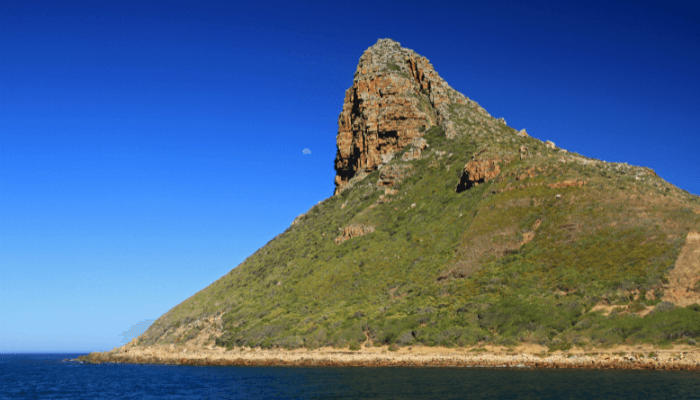

Similarly, strong waves carrying sand and silt deposited and simultaneously eroded coastal rocks creating the Cape on the Atlantic coast of Africa as part of the Table Mountain ranges. Composed of sandstone, their edges were easily eroded by wind and water forces, leaving behind the hard and rugged cape.
The discovery of the Cape dates back to the Age of Exploration. Between the 15th and 16th centuries, European powers like the Spanish, Portuguese and the Dutch sent royal missions to unexplored lands to find riches, expand their empires and spread Christianity among the new subjects.
This presented a great opportunity for independent sailors and explorers to gain the crown’s favour. One such explorer was Bartolomeu Dias, the first European who discovered the Cape of Good Hope while trying to find the southernmost point of Africa. Subsequently, he found the trade route from Europe to Asia through the Atlantic and Indian Oceans.
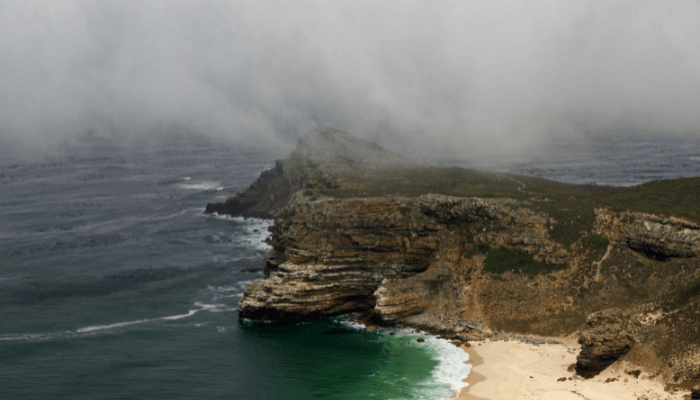

The rocky cape was initially named the Cape of Storms by Dias whose fellow crew members were terrified of the harsh weather and rough tides. It was dangerous to navigate as storms were common in the area. Later, the King of Portugal, John II renamed it the Cape of Good Hope because it allowed the empire to trade with Asia.
Cape of Good Hope occupies a crucial place in the trading history of South Africa. It acted as a stopover for vessels sailing from Europe to the colonies of the Far East. However, the Europeans mercilessly uprooted the indigenous Khoikhoi people from their lands to gain control over the Cape.
A provision camp was established by the Dutch East Company in the Cape Peninsula, close to the Bay. It provided food, water and shelter to arriving sailors but later took the shape of a full-fledged settlement, presently called the Cape town. It was founded by a Dutch merchant named Jan Van Riebeeck in 1652, near Table Bay. The Cape remained under Dutch control from 1652 to 1795.
After the 1814 Anglo-Dutch Treaty, the Cape of Good Hope became a British possession called the Cape Colony. After British colonisation, it became a hub for the African slave trade in the 18th century.
The coastal areas along the Cape enjoy a mild, Mediterranean climate similar to the sea-facing regions of central and southern California, parts of Chile, Australia and the Mediterranean sea. It has mild winters and warm and dry summers.
Summer winds are popularly called ‘the Cape Doctor’ by locals. These winds clean the air by blowing out pollution from the region and enable oxygen dissolution into the Bay’s shallow water, supporting marine life, especially crabs, lobsters and small fish.
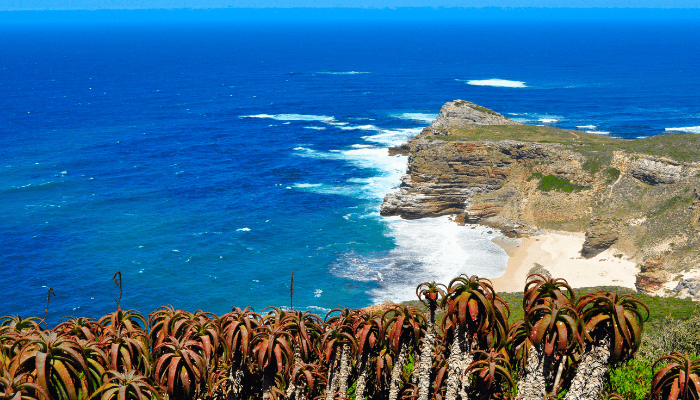

Since the cape is located at the confluence of the warm Indian ocean current, the Mozambique-Agulhas and the cold Benguela current from the Antarctic, it has turbulent waters. The strong winds blowing towards the southern end of the African coastline give rise to axial and transverse wind systems on the False Bay, generating high tides.
The Cape is home to over 1000 shipwrecks. Hence it is popularly known as the graveyard for ships. Sailors are advised to tread carefully in the waters while maintaining an average sailing speed.
It swallowed the British cargo ship, Arniston, carrying wounded soldiers from Sri Lanka. On 30th May 1815, the vessel was caught in a storm and mistook Cape Agulhas for Cape Point. Captain George Simpson steered her westward and reached a steep reef without using an anchor. He tried to turn the ship but in vain. Only 6 out of 378 people survived.
In honour of the deceased, a nearby town was named Arniston, and a museum was built to recount the sad tale of the British soldiers who never reached home. A lighthouse was also erected at the reef to prevent ships from taking the unfateful route. Today, the wreckage of Arniston is a diving spot explored by many who visit Cape Town.
Also known as Australia’s Titanic, SS Waratah was a cruise liner and a cargo ship. It was constructed by Scottish shipbuilders who flaunted its strength, beauty and excellent craftsmanship. On one of its voyages from Durban to Cape Town in July 1909, the ship was lost in a severe storm and never found. Rescue operations went on for years but its whereabouts remain a mystery. Experts believe that powerful waves tore the vessel into pieces which lay scattered in the ocean.
The Cape of Good Hope is beautiful yet dangerous. Many legends like the sighting of mermaids, sea monsters and paranormal occurrences are recounted by local fishermen and natives of the area.
Most popular is the legend of haunting pirates or the myth of the Flying Dutchman. Portrayed in movies, books, and tv shows, the tale is known to many. Many people believe that the ship was cursed to sail the Cape’s water to eternity. Although it is a legend, people have claimed to have sighted the ghost ship on stormy nights and foggy days. Sailors have named it the Flying Dutchman as the ship doesn’t seem to touch the water. Interestingly, a train ride named after the vessel can be found at Cape Point.
According to the myth, Captain van der Decken came from the Far East in 1640. As he reached the cape, his ship was caught in a storm however he refused to give up. He vowed to sail around the Cape till the Day of Judgement, which angered the gods.
Cape of Good Hope has been a subject of tragic poetries, the most famous being the Os Lusiadas written by Portuguese poet, Luis de Camoes in 1572. Using a Greek mythological character, he underlined the navigational difficulties and dangers faced by sailors while crossing the Cape of Storms.
Sandy beaches and seaside resorts are major attractions near the Cape of Good Hope. Travellers can contact local tour operators or explore the region themselves. It is the perfect place for nature lovers and adventure sports enthusiasts.
The rugged mountains are ideal for a hiking trip or camping. Biking contests and yacht races are organised by the authorities frequently. One can also enjoy fishing, diving, surfing, angling and bird watching.
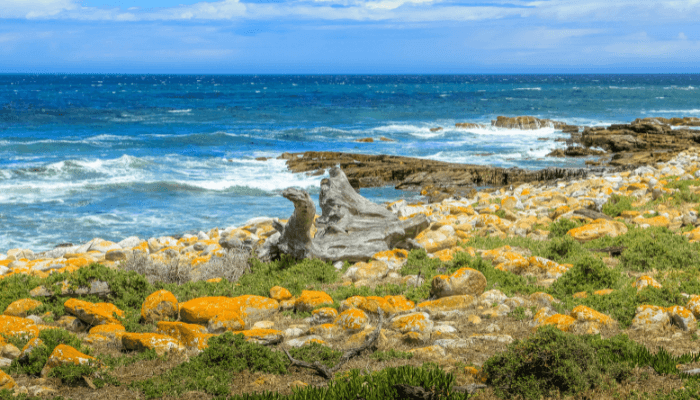

Located inside Table Mountain National Park, the Cape is a picturesque location. A winding road from Cape Point leads to Smitswinkel Bay and Millers Point. The former is a famous diving spot while the latter is known for its diverse baboon population.
Having a rich socio-cultural heritage, Cape of Good Hope has many museums and local restaurants that sell authentic food at affordable prices. Secondly, the Cape is dotted with many lighthouses, each with a history of its own.
Usually crowded, the Cape Point Lighthouse provides the best sunset views. A small museum is close to the lighthouse and showcases the Cape’s history. The tallest iron lighthouse in South Africa is located in Kommetjie. Known as the Slangkop Point lighthouse, it was constructed in 1919.
People can also go whale watching or explore the ocean by renting a boat from the Simon town harbour. A Victorian-era village town, Simon harbour is the base of South African naval forces.
Another famous attraction is the Ostrich Farm at Cape Point, just 500 metres from the Cape of Good Hope Reserve. Also called the surfer’s haven, the Muizenberg beach has vibrant huts and cabanas. The Silvermine sanctuary is rich in wildlife. People can visit the nearby Boulder beach to see colonies of African or the Jackass penguins.
Cape of Good Hope is a landmark for vessels sailing to East Asia and Australia. Located near the Cape are a few South African ports, the biggest being the port of Cape Town.
Situated in Table Bay, a few miles from Cape of Good Hope, the Cape Town harbour has four basins and 34 berthing facilities. Duncan and Schoeman wharves handle commercial cargo carriers. Private berths are found in Victoria and Alfred Basins, sheltered by two main breakwaters.
Since the region is a major agricultural zone, a large proportion of export commodities include citrus fruits, juices, canned and fresh seafood, vegetables, polymers, rice, metal, meat, cement, copper ingots etc. Imports include heavy machinery, steel products, wood, sports gear, clothing, chemicals and so on. Approximately 3000 ships carrying over 8 million tonnes of cargo and over 300,000 TEUs visit the port annually.
Another major port is Mossel bay harbour, located 400 kilometres from Cape Town. It serves the hinterland and is visited by fishing vessels, passenger boats and service crafts. Bunkering and freshwater provisions are available at the port.
The port is protected by a 540-metre long breakwater and has six wharves for handling mineral ores, manufactured items, fish, bulk sugar, metals and general cargo. It has two oil jetties linked to local oil and natural gas plants. They are used for shipping refined petroleum to neighbouring regions.
A protected area and a UNESCO World Heritage Site, the Cape Peninsula covers 480 square kilometres. It is home to over 2500 species of plants and animals. On its southern end is the Cape Floristic Region, which covers 0.5 per cent of the African continent but holds over 20 per cent of native African flowering plants. Most common are shrubs or bushes called fynbos.
Table Mountain Park protects endangered species of antelopes and is famous for the Chacma baboons. One can spot bontebok, foxes, elands, red hartebeest and deer grazing in Smitswinkel grasslands.
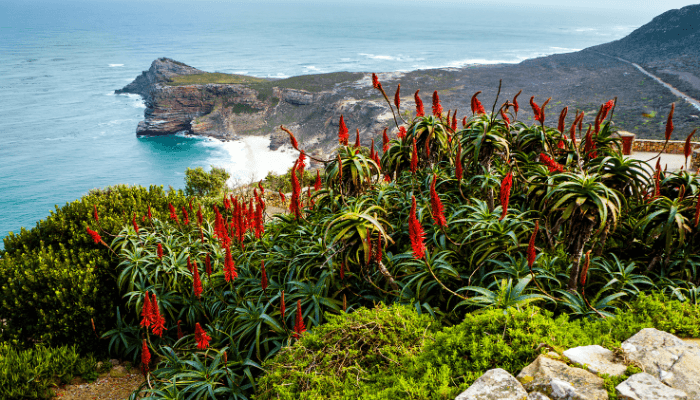

Small mammals such as hyrax, striped mice, clawless otters etc are also found. The region is perfect for whale watching too. The southern right whale dominates False Bay while other species like humpback whales and blue whales can also be seen.
Seals, dolphins and orcas also inhabit the Cape’s waters. Tourists visit the Cape’s beaches which serve as nesting grounds for many bird species like the gannet, black oystercatcher and African penguins. The Cape is filled with native butterflies, bees and sunbirds in Spring.
The magnificent flying lizard, numerous tortoise species and vibrant insects inhabit the coastal areas. Lastly, the Cape is famous for the Mountain Zebras, a species spotted rarely.
You might also like to read:
Disclaimer: The authors’ views expressed in this article do not necessarily reflect the views of The Marine Learners. Data and charts, if used, in the article have been sourced from available information and have not been authenticated by any statutory authority. The author and The Marine Learners do not claim it to be accurate nor accept any responsibility for the same. The views constitute only the opinions and do not constitute any guidelines or recommendations on any course of action to be followed by the reader.
The article or images cannot be reproduced, copied, shared, or used in any form without the permission of the author and The Marine Learners.










We believe that knowledge is power, and we’re committed to empowering our readers with the information and resources they need to succeed in the merchant navy industry.
Whether you’re looking for advice on career planning, news and analysis, or just want to connect with other aspiring merchant navy applicants, The Marine Learners is the place to be.